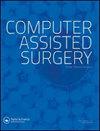Force–torque intraoperative measurements for femoral shaft fracture reduction
IF 1.9
4区 医学
Q3 SURGERY
引用次数: 8
Abstract
Abstract Background: The minimally invasive technique of closed intramedullary (IM) nailing fixation is currently considered the standard of treatment for the operative management of displaced traumatic fractures of the femur, with fracture reduction and repositioning being the first and most important step of the procedure. Skeletal-muscle traction and alignment of the fracture fragments are always performed as individual components of the reduction and repositioning phase of the procedure. Methods: As use of high traction force and repositioning forces and torques can cause additional soft tissue injury, we developed a sensor-based system to monitor these forces and torques during the treatment of diaphyseal fractures of the femur, including the monitoring of traction forces during the entire procedure, from reduction to IM nail implantation and fixation. Results: Based on a local coordinate system localized at the center of the fracture, maximum forces of 203 N along the medial-lateral (X) axis, 517 N along the anterior–posterior (Y) axis and 505 N along the shaft of the femur (Z-axis) were identified, with maximum torques of 16.4 Nm calculated around Y-axis and 38.3 Nm around X-axis. The pressure between the counteraction post and the perineum was also recorded, with magnitudes as high as 523 N being recorded. Excessive forces were identified and the difference in force–torque magnitudes during different stages of the reduction and fixation procedure were calculated. Conclusion: The measurement system provides surgeons with real-time information which can assist them in performing effective repositioning of fracture fragments within safe margins of applied forces and torques.股骨干骨折复位术中力-扭矩测量
背景:闭式髓内钉(IM)微创技术目前被认为是外伤性股骨移位骨折手术治疗的标准技术,骨折复位和复位是手术的第一步也是最重要的一步。骨骼肌牵引和骨折碎片的对准总是作为复位和复位手术阶段的单独组成部分进行。方法:由于使用高牵引力和重定位力和扭矩会导致额外的软组织损伤,我们开发了一种基于传感器的系统来监测股骨骨干骨折治疗过程中的这些力和扭矩,包括从复位到内钉植入和固定整个过程中的牵引力监测。结果:基于位于骨折中心的局部坐标系,确定了沿内侧-外侧(X)轴的最大力为203 N,沿前后(Y)轴的最大力为517 N,沿股骨轴(z)轴的最大力为505 N,沿Y轴计算的最大扭矩为16.4 Nm,沿X轴计算的最大扭矩为38.3 Nm。还记录了反作用力桩与会阴之间的压力,最高可达523 N。确定了过大的力,并计算了复位和固定过程中不同阶段的力-扭矩大小的差异。结论:该测量系统为外科医生提供了实时信息,可帮助他们在安全的外力和扭矩范围内有效地重新定位骨折碎片。
本文章由计算机程序翻译,如有差异,请以英文原文为准。
求助全文
约1分钟内获得全文
求助全文
来源期刊

Computer Assisted Surgery
Medicine-Surgery
CiteScore
2.30
自引率
0.00%
发文量
13
审稿时长
10 weeks
期刊介绍:
omputer Assisted Surgery aims to improve patient care by advancing the utilization of computers during treatment; to evaluate the benefits and risks associated with the integration of advanced digital technologies into surgical practice; to disseminate clinical and basic research relevant to stereotactic surgery, minimal access surgery, endoscopy, and surgical robotics; to encourage interdisciplinary collaboration between engineers and physicians in developing new concepts and applications; to educate clinicians about the principles and techniques of computer assisted surgery and therapeutics; and to serve the international scientific community as a medium for the transfer of new information relating to theory, research, and practice in biomedical imaging and the surgical specialties.
The scope of Computer Assisted Surgery encompasses all fields within surgery, as well as biomedical imaging and instrumentation, and digital technology employed as an adjunct to imaging in diagnosis, therapeutics, and surgery. Topics featured include frameless as well as conventional stereotactic procedures, surgery guided by intraoperative ultrasound or magnetic resonance imaging, image guided focused irradiation, robotic surgery, and any therapeutic interventions performed with the use of digital imaging technology.
 求助内容:
求助内容: 应助结果提醒方式:
应助结果提醒方式:


